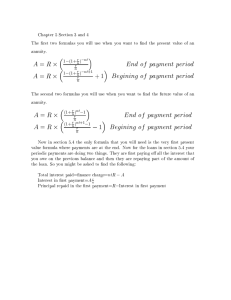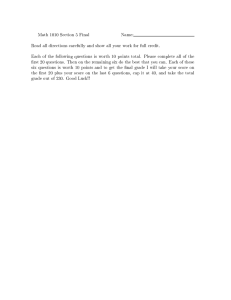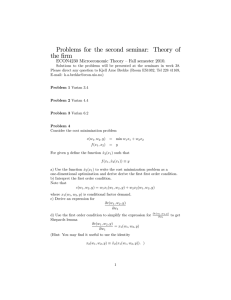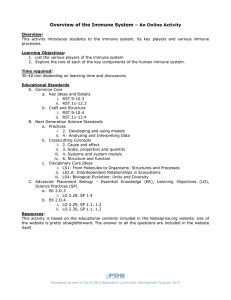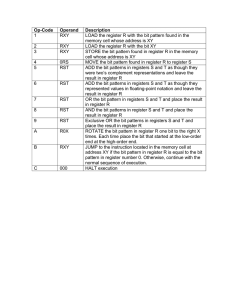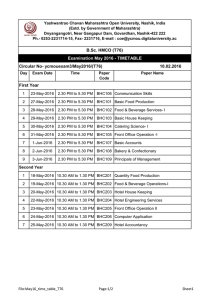This research entitles “Influence of Traffic and Transportation Characteristic CHAPTER 1
advertisement
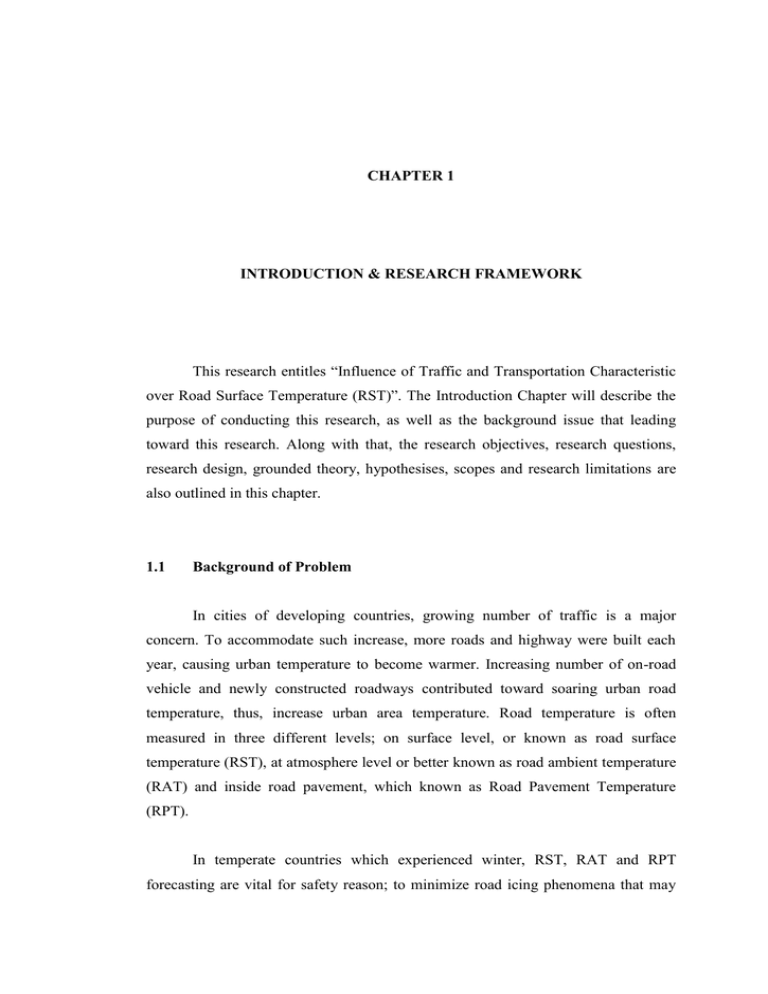
CHAPTER 1 1 INTRODUCTION & RESEARCH FRAMEWORK This research entitles “Influence of Traffic and Transportation Characteristic over Road Surface Temperature (RST)”. The Introduction Chapter will describe the purpose of conducting this research, as well as the background issue that leading toward this research. Along with that, the research objectives, research questions, research design, grounded theory, hypothesises, scopes and research limitations are also outlined in this chapter. 1.1 Background of Problem In cities of developing countries, growing number of traffic is a major concern. To accommodate such increase, more roads and highway were built each year, causing urban temperature to become warmer. Increasing number of on-road vehicle and newly constructed roadways contributed toward soaring urban road temperature, thus, increase urban area temperature. Road temperature is often measured in three different levels; on surface level, or known as road surface temperature (RST), at atmosphere level or better known as road ambient temperature (RAT) and inside road pavement, which known as Road Pavement Temperature (RPT). In temperate countries which experienced winter, RST, RAT and RPT forecasting are vital for safety reason; to minimize road icing phenomena that may 16 cause road‟s surface slipperiness. However, in tropical countries which are located nearer to the equator, and experiencing hot climate throughout years, the characteristics and study on dispersion of RST and RAT is often neglected, although they significantly contribute toward urban heat agglomeration which is an important factor to create comfortable walking environment for pedestrian. Thus, it is very important for us to study factors that contribute toward increasing pattern of road temperature, so we could create better walking environment for pedestrian and reduce urban temperature. Transportation is the second largest energy consumer in global scale after industrial sector (refer Figure 1-1). This sector was identified as one of the most contributing sector toward increasing urban temperature pattern worldwide as energy generation will resulted in heat emission. According to Xu, Wooster and Grimmond (2008), storage heat flux of road is the highest; around 420 W m-2, exceeding other urban surfaces heat intensity such buildings, water, and vegetated areas. Chudnovsky, Ben-Dor and Saaroni (2004), also had identify road surface as the warmest surface in their diurnal thermal behavior study over selected urban objects. An always increasing number of on-road vehicles not just consume enormous amount carbon based energy, but also releasing huge amount of anthropogenic heat, generated from vehicles‟ engine combustion (Prusa 2002). Worst, thousand miles of new roadways were built each year, reflecting more solar radiant, causing urban area to become hotter compared to rural area, thus resulted in urban heat island phenomena (UHI). Source: EIA Global Energy Watch Report (2007) Figure 1-1 Global energy consumption based on sector. 17 High RST and RAT contribute much toward increasing pattern of urban temperature. In a case for a tropical country like Malaysia, which majority of development in urban area are located along main transportation corridors, it is very important for us to investigate deeper the characteristics of road temperature as it may infectiously increase surrounding temperature and lead toward the UHI phenomena and global warming phenomena. Although there had been several scholars emphasized of the significant influence of traffic or transportation infrastructure characteristics over road temperature (Chapman & Thornes 2011; Chapman & Thornes 2005; Kalthoff et al. 2005; Prusa et al. 2002; Chapman, Thornes & Bradley 2001; Gustavsson, Bogren & Green, 2001), and the effect of transportation characteristic over global warming phenomena either directly or indirectly (Uherek et al. 2010; Unger, Shindell & Wang 2009; Akisawa & Kaya 1998; Imaseki 1998), characteristic of urban road temperature remain unaddressed or less addressed by scholars, especially in tropical countries. Studies related to UHI phenomena had been extensively done by scholars all around the world, such by Henry et al. (1989); Casselles et al. (1991); Gallo and Owen (1998); Voogt and Oke (2003); and Jusuf et al. (2007). While in Malaysia, the UHI issue had also been widely addressed such by Shaharuddin, Noorazuan, and Yaakob. (2008), Kubota and Ossen (2008), and, Takeuchi, Noorazuan and Thei (2010). In most of these UHI researches, satellite remote sensing data had been widely use to acquire surface thermal distribution and land cover data. All of this researches studied on spatial distribution of urban temperature based on various land uses and land cover in general, without giving special nor detail attention to spatial temperature distribution of a specific land use, respectively, transportation related land use. As global warming had become a global issue increasing in significant, it is very important for researchers to study every single elements that contributed toward escalating urban temperature. Especially when it related to a sector which is second largest energy consumer and heat polluters in the world; transport related sectors such on-road heat pollution. By looking at details urban characteristics such as traffic volume, number of road lanes, road pavement materials, road alignment, number of junction, road density, urban density, building intensity, sky-view factor, abundant of 18 green area, topography, distance from city centre, and distance from shoreline, for each road stretch, we could study the profile and nature of road temperature in tropical countries better. Thus, later, enable us to identify appropriate mitigation actions to counter situation that resulting toward high road temperature condition, and reduce probability of significant heat pollution in urban area that may lead toward global warming. This type of research is known as “Research on Road Climate, or Road Climatology”. High road temperature in urban area has several impacts either toward urban microclimate, environment, ecology, economy, dwellers‟ health level and also their psychology. Most of them are cyclic and chained effects. Heat pollution from roadways and traffic are making urban area to become hotter, and contribute in higher urban energy usage for air conditioning, and higher carbon dioxide emission, thus cause alteration of natural urban climate which later causes irregular heavy rain, flash flood, irregular fruit seasons and spread of deceases. Walking is the most sustainable mode to travel and the most important mode of travel that were used by every single people. Warm roadside areas are also not preferable for pedestrian to walk in urban area. High heat pollution along our road stretch will discourage walking activities, as there are feelings of uncomfortableness, especially in hot climate tropical countries. This condition is not helping toward promoting sustainable urban transport system. Additionally, warm surface water that flow beside roadway may also change the water temperature of river and lake where the water flow, thus affected the thermal balance within the aquatic ecosystem. As a result aquatic life such plankton; which is main diet for small fish, will not be able to breed, while algae will also be affected due to hydro thermal change. Extreme heat pollution from transport infrastructure in urban area also may affect human psychology. Hot condition will affect enzyme in human body, and cause the feeling of uncomfortableness. Whenever a human live in an uncomfortable environment polluted by heat, they are unable to neither operate nor think in optimum level and exposed to certain type of illnesses such dehydration and hallucination. More than that, abundant of urban heat pollution, may increase risk of death due to heat wave (Huang, Zhou & Cadenasso 2011). 19 For all the above reasons, studies related to characteristics of road temperature need to be done thoroughly. Questions such as what cause high road temperature? Why road temperature does is high in certain areas? What type of transportation related characteristic resulted in higher road temperature? What traffic characteristics that influenced high road temperature? Are vital to be answered in order for us to understand more, issues related to road temperature in tropical urban. For then, we could understand better the transportation and traffic characteristic that may result toward higher road temperature, thus, mitigation actions can be executed. 1.2 Problem Statement Little researches had been done to anticipated traffic related factors that contribute toward urban road temperature characteristics. Maybe due to difficulty to gather temperature data and traffic related data, and, difficulty to analyze the significant of traffic and transport related characteristics such as had been state by Prusa et al. (2002); and Shou (1990, cited in Chapman, Thornes & Bradley 2001). This situation is not favaourable, as roadways connected every single entities in an urban area, and because of that, road temperature, may influence urban climate as a whole. More than that, through literature reviews, study related to road temperature in tropical country had yet to be published. Thus, urgency to come out with research of road temperature in tropical cities, emerged, due to the known important or chain effects of high road temperature toward urban microclimate, environment, economy and dwellers. Above all, the main question of this issue arises; what are the most significant factors that contribute toward road temperature trend in tropical countries? In context of this research, does transportation related attributes such traffic volume, type of vehicles, road hierarchy, road segment or alignment (straight, junction, and corner), speed and even road density; affect road temperature intensity or distribution? There are also question related to whether really traffic characteristics such traffic volume, type of vehicle and traffic speed do affect road temperature? 20 Previous studies that related to road temperature, notably road surface temperature (RST) had been done extensively by scholars in western countries especially temperate countries. They had used various kind of method and platform; fix field stations (Gustavsson, Borgen & Green 2001), vehicle mounted with infrared camera (Chapman, Thornes, & Bradley 2001), on-ground remote sensing and airborne remote sensing, as their instruments. All of these methods are limited in term of study area, as they may only cover either one or several routes, and small site or a medium scale study area. Worst, those methods required lots of time to cover those wide area, and difficult to be analyzed spatially in short period of time; which are not preferable for ad hoc planning decision making. Capability of emerging satellite thermal remote sensing may be used to overcome study area limitation. By using thermal-infrared band from satellite, researcher can study distribution of urban surface temperature (UST) in larger scale, and wider area as satellite such as Landsat ETM cover an area of at least 100km square at the resolution of 30m; suitable to study regional context entities, while the thermal band resolution is 60m (Chapman & Thornes 2011). Data of road surface temperature (RST) intensity may be extracted from UST data processed from these satellites. Thus, regional‟s spatial distribution of RST might be observed, and studied. Geographical reference in remote sensing data further, enable researcher to study correlation between road temperature and its surrounding geo-physical environment such road density, and traffic characteristics that had been georeferenced in particular coordinate. Although in previous studies had states various urban attributes that might influence RST such such latitude, altitude, topography or elevation, sky-view factors, screening factors, land use mixture, road materials, distance from city centre, urban street canyon, wind, or solar radiation, this research only emphasis on the influences of traffic and transportation related attributes such traffic volume, type of vehicles, road hierarchy, and road network density. The reasons were because four (4) of those factors had never been thoroughly investigated simultaneously and thoroughly in studies before, especially related to effect of type of vehicle toward surrounding road temperature. Nevertheless, such study had not been carried in tropical countries as 21 far as literature review of this research was concerned. It is vital to look at these factors simultaneously in a study, as their effects on surrounding temperature may differ, if different site or time is used to investigate them. 1.3 Research Objectives This research aimed to study influences of various traffic and transportation characteristics toward intensity of road surface temperature (RST) by combining the used of ready traffic data and remote sensing method. Following are the objectives of this study: 1. Extracting Iskandar Malaysia road surface temperature (RST) data from Landsat +ETM 7 satellite platform and producing the RST distribution map. 2. Evaluating effect of road density on RST intensity. 3. Comparing different road hierarchy effect over road temperature distribution. 4. To evaluate effect of higher traffic volume towards road temperature. 5. To study the influence of different vehicle composure toward RST characteristic. 6. Evaluating capability of satellite thermal remote sensing data on RST related research. 1.4 Research Questions The main question of this research is how traffic and transportation characteristics influence distribution and intensity of road surface temperature (RST) in tropical urban area. Following are the main questions that are addressed by this research: 1. What is the RST distribution pattern in Iskandar Malaysia? 2. Does RST may be influenced by road density? 3. Does road hierarchy have any significant over road temperature? 4. Does higher traffic volume result in higher road temperature? 22 5. Does different type of vehicle or different traffic composition affect RST characteristics? 6. May RST extracted from satellite data be used to explain correlation between road surrounding temperature and traffic characteristic? 1.5 Research Hypothesis Main research hypothesis of this study is road surface temperature (RST) do influenced by different traffic and transport characteristics, and also by its surrounding urban features. Listed are other hypothesizes used in this research: 1. Higher road density favorably resulted in higher RST intensity. 2. Road of higher hierarchy should have higher average RST compared to those roads that are lower in the hierarchy as they cater more traffic volume. 3. Higher traffic volume should result in higher average temperature value as amount of heat released by vehicles increase. 4. Different type of vehicle may release different magnitude of heat, thus they also may have effect on differing temperature surrounding a route. 5. More heavy vehicles resulted in higher temperature. 1.6 Theoretical Framework This research is conduct based on theory that larger number of vehicle and denser road surface with in city will result in higher surrounding temperature in urban area (Farmer & Tonkinson 1989, cited in Gustavsson, Bogren & Green 2001; Surgue et al. 1983, cited in Prusa et al. 2002). Heat pollution caused by transportation activities, will affected its adjacent area temperature. According to Zeroth Law of Thermodynamic, heat will be transferred from a system that has higher heat volume to a system that has lower heat volume, until a condition which known as thermal equilibrium is achieve. 23 The amount of heat in a system maybe measure by temperature. In thermal equilibrium condition, heat will only stop to move once temperature of a particular area and its adjacent area are equal. In other words, high road temperature that cause by larger traffic movement in a route, will end up increasing temperature of its surrounding area in Euclidean direction. Several scholars had study influence of traffic or transportation infrastructure characteristics over road temperature. Researcher such as Chapman and Thornes (2011); Chapman and Thornes (2005); Kalthoff et al. (2005); Prusa et al. (2002), Chapman, Thornes and Bradley (2001); Gustavsson, Bogren and Green (2001), had validate the correlation between characteristic such traffic volume, street canyon, screening factor and material of road surface. Thus, based on their findings and conclusions, theoretical frameworks for this study were constructed. Further discussion over this framework was elaborated in second chapter of this dissertation. 1.7 Scope of Research The main scope of this research is to investigate only the characteristic of urban road temperature in term of road surface temperature (RST) and giving focus only on the traffic and transportation related attributes influence. The followings are scope of this research: 1. This research only analyzed road surface temperature of transportation features, and traffic data for year 2008 within Iskandar Malaysia‟s boundary. 2. The RST data use is based on earth surface temperature extracted from Landsat +ETM 7 satellite taken on 11 October 2008. 3. Traffic volume data used was based on the Highway Planning Unit, Malaysia Public Work Department traffic survey conducted on October 2008. 4. This study will cover only roads as it was, in the Iskandar Malaysia geographical information system (GIS) database of year 2008. And so does other spatial data used for this research such administration boundary, landuses and road characteristic. 24 5. This study only looked at factors of: 1.8 i. Road hierarchy iii. Type of vehicle ii. Traffic volume iv. Road density Research Assumptions Researcher assumed that there was no influence by other urban features over road surface temperature (RST), except for tested urban transportation and traffic related characteristics in this research. The following are other supplementary assumptions used in this research: 1. Researcher assumed that satellite thermal data used for this study were acquired on the same date (day) on year 2008 with the following data: a. Traffic count data from the Highway Planning Unit, Public Work Department were taken on the same date and time such the satellite data. b. The several traffic count data at particular location, does represent traffic characteristic in the studied area. c. All spatial data within the Iskandar Malaysia geographical information system (GIS) were true on the same date as traffic count and the day satellite thermal data was acquired. 2. All other factors such as wind, air temperature, urban density, green area, altitude, distance from coast line, and solar radiance, factor is equal all around the study area or did not influence the RST. 1.9 Limitations of Research This research‟s design, analysis methodology, and results were based on several limitations as listed below: 1. The accuracy of calculated road surface temperature (RST) was based on RMS error and resolution of the used Landsat ETM+ 7 data which are less than 1.000 and resolution of 30m for spectral band, and 60m for thermal 25 band. However this shortcoming was overcome through interpolation and area‟s temperature average method. 2. Traffic related data is only based on traffic survey data on specific points in selected routes by Public Work Department of Malaysia. 3. Difficulty to obtain satellite thermal data and traffic survey data for exactly the same date to be compared in this study. 1.10 Significant and Expected Contributions of Research The escalating pattern of urban temperature since the past 20 years (refer Figure 1-2) is a clear indicator that appropriate actions must be takes to mitigate the trend. As global warming becoming obvious threat, all causing factors that contribute toward increasing urban temperature must be carefully address. Pandemic, alteration in urban micro climate, deadly heat wave phenomena, extinction of hydro creature due to change in water temperature due to road surface thermal pollution that flow in to water, and heavier usage of cooling device, are just among the small reasons, why we need to be concern of road surface temperature (RST) intensity in urban area. High road temperature is among of the factors that silently contribute much toward excessive urban heat pollution. Yet, little emphasis had been given to road temperature, especially by tropical countries. Source: Malaysia Meteorological Department Website Archive (October 2011) Figure 1-2 Increasing average temperature in Iskandar Malaysia Region for the period of 1969-2009 26 This research will ensure deeper understanding that lay before high urban temperature, especially related to characteristic and distribution pattern of road temperature in urban area. Understanding related to road temperature and influence of several urban features; building density, building intensity, agglomeration of road network, preservation of green area, and traffic volume, will allow transportation planner and urban designers to better understand this phenomena by identifying the road temperature pattern, characteristic, inter spatial relationship and distribution, based on transportation, traffic and urban geographic characteristic. Thus, enable transport planners and decision makers to take appropriate mitigation actions whenever they plan future urban development or expansion, especially urbanregional transportation planning. Transport planner would used findings of this researches to disaggregate traffic according to class in better manners, while urban planner might align road network and road stretch accordingly, so that thermal pollution causes by roadways in urban area would have minimum impact on urban residents. While ecologist or environmentalist would anticipate the area which will have high RST, to outline mitigation action so that thermally polluted water from road area will not directly flow into our river, and destabilize the whole river ecosystem. All of these will in the end lead to a better urban environment that is less affected by road based heat pollution, thus create a more sustainable cities in tropic country. Finding of the most significant factors that influence RST also will pioneer the development of a road climate model specific for the use of cities in tropical countries, especially in hot spots area and area that had been identified by the model to be in intense temperature condition due to road related characteristics.. That model will enlighten and assist transportation planner and urban planner to plan our roadways, transportation system and other urban features so that road temperature in our cities will not be that high, and not becoming an environmental, health, and economic threat toward urban populations. In other hand, emerging new technology of thermoelectric-photovoltaic (TEPV) to nurturer electricity from road heat energy, will require extensive study on road temperature characteristic and distribution. This TE-PV technology capitalizes 27 on heat waste from road surface and vehicle engine combustion, to generate electricity (Zhang & Chau 2011). As tropic countries usually exposed to all year of intense sun light, it is the best location for energy harvesting using of thermoelectricphotovoltaic method, which are renewable energy, not based on carbon and sustainable. Availability of a good road temperature model will help determining best location to harvest energy based on road heat waste, along tropical countries‟ roadways. 1.11 Research Design This research started by reviewing previous studies that had been made by researchers, in order to identify possible factors that might influence road temperature characteristics, especially transportation and traffic related characteristics. These identified factors were then studied based on their overlying theory and previous research results and suggestions. Based on those literature and theories reviews, all the factors related to transportation and traffic which have significant toward road temperature characteristics in tropical countries were retrieved, to be tested. Figure 1-3 Research Methodology and Design. The road surface temperature (RST) data retrieved from Landsat ETM+ 7 satellite by using ENVI remote sensing software and utilizing the mathematical 28 Planck model developed by NASA which explained further in methodology chapter. The satellite thermal data was used to study the road temperature profile of different route, and to compare the different profile road temperature based on different traffic and transportation characteristics. The used of spatial analysis capability in GIS was utilized to investigate influence or correlation between road surface temperature (RST), against listed transport and traffic attributes. Each of four (4) identified variables or factors that might influence road temperature intensity were then tested by using linear regression model and comparison analysis. By this method, correlation and influence of each traffic characteristic; volume, vehicle type, road‟s density and road‟s hierarchy were identified. 1.12 Chapter Outlines This written dissertation will consist of five (5) main components; i) Introduction and Research Framework, ii) Literature Reviews, iii) Research Methodology, iv) Findings, Analysis & Discussions, and v) Research Summary. Part 1 – Introduction and Research Framework This chapter is a guiding chapter throughout this whole research, outlining the whole aim and objectives of this research and method use to carry out this research in general. This introduction chapter highlighted the issue of high road surface temperature (RST) in tropical country and relation with global warming phenomena and UHI phenomena, and other related problem cause by this issue. Thus significant of this whole research was explained. This chapter will also include basic literature reviews of previous study and theory related to road temperature, assumptions used, scopes and limitations of this study, significant of this study and research design for this whole study. 29 Part 2 – Literature Review Second part of this research is the literature reviews. This chapter will focus on the overlaying theories related and influencing factors that contribute toward road temperature characteristics, defined by scholars. This chapter will also discuss on the issues arise by researchers in their studies of road temperature characteristic, with emphasis on method that they used, data that had been manipulated, and result that they had obtained from those previous studies. Part 3 – Methodology This chapter explained methods used in this research, especially specific methods used to study each factor that contributed toward road surface temperature characteristics and distribution. This segment also further described and elucidated on the data acquired, software or tools used to evaluate, steps and model used in analyzing significant of each tested factors, and, method used, to produce listed comparison and analysis earlier. Part 4 – Findings, Analysis & Discussions The fourth part of this written dissertation will discuss all the analysis done based on listed method and given objectives of this research. Each analysis findings were discussed, elaborated and explained thoroughly based on analysis outcome. The chapter was concluded with summary of analysis and finding that reflected this research‟s questions. Part 5 – Research Summary The last chapter of this thesis will provide summary for this whole research. Starting from the emerging issue, to research aim and frameworks, summary of literature review of previous studies, methods used, discussion of results and findings, and discussion related to the road temperature characteristic. This chapter also explained all the shortcomings of this study, and suggestions of possible increments for future researches. 30 1.13 Chapter Summary Road temperature study is relatively a new study, especially in Malaysia. However, due to escalating global and urban temperature and vehicles number each year, study related to road temperature is vital. Factors that contribute toward high road temperature in urban area should be investigating, thus, mitigation action to reduce urban, especially road temperature in the future might be planned and taken. For that reason, this research is significant. In the nest chapter, researcher thoroughly listed, describe, explain and discuss, several studies done by scholars especially related to traffic and transportation characteristics, thus overlaying and further explain the overlaying framework of this whole research.


